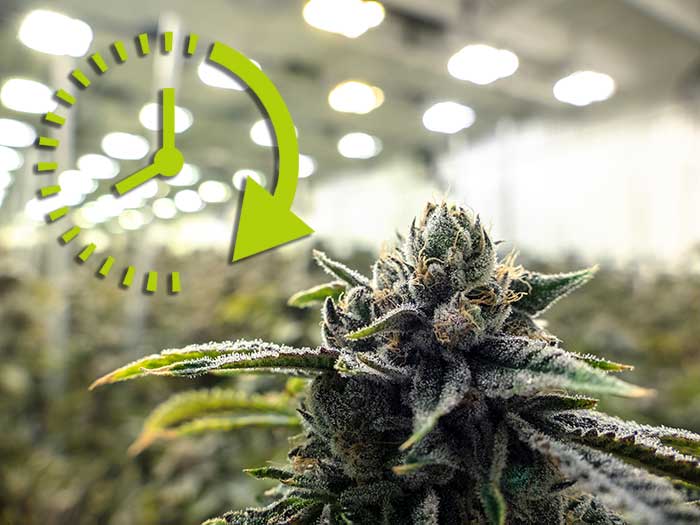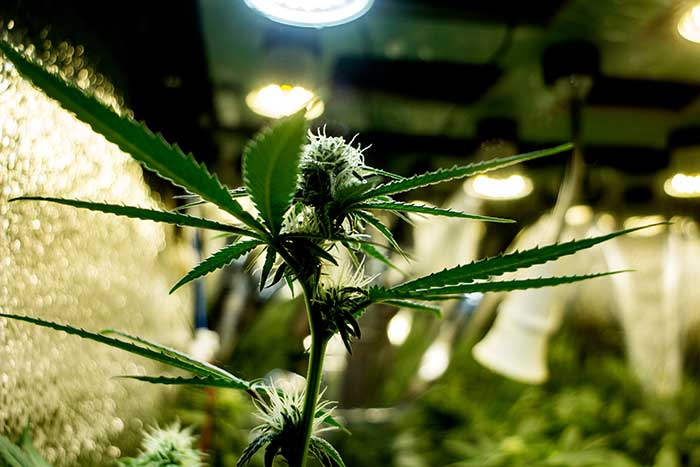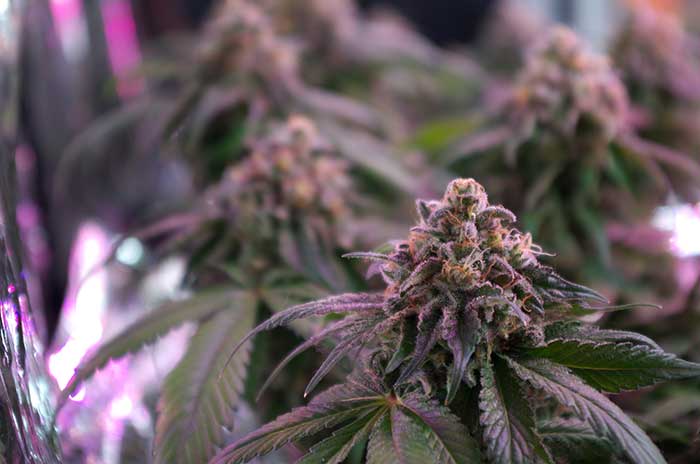Light cycle in the flowering period and floral growth

Cannabis plants need an average of 2 weeks to change from vegetative growth to flowering. During the flowering period, plants need a different combination of nutrients than during the growing phase. Flowering plants prefer less nitrogen and more phosphorus. However, nitrogen should not be completely withdrawn even during flowering because cannabis plants still need healthy leaves to develop ideally.
Excessive nitrogen in the nutrient tank or planters should now be removed by rinsing with clear water. A suitable NPK ratio is 1-3-1 and 3-5-3.
In principle, the use of nutrients should be kept to a necessary minimum during the flowering period, because fertilisers can produce a chemical taste in the buds. Organic fertilisers provide a pleasant and intense flavour to the buds, but should also only be used as much as necessary, because they can also leave a slight taste. 1-2 weeks before harvesting, it is recommended to stop using fertilisers completely to remove excess fertiliser residues from the plants.
The prebloom
Growing conditions and light should be stable and complete throughout the flowering period. An unstable light cycle and incident light (even if it is very little) during the dark period can disturb or even prevent pre-blooming.
A timer ensures that the light cycle is stable and that the lights always go on and off at the same time. Experienced growers do everything to prevent "light pollution" during the dark phase, as this is one of the biggest stumbling blocks on the way to big juicy buds.
Proper pruning and plant training encourage maximum flowering. However, pruning should be largely completed before sending the plants into flower.
The only pruning done in the flowering period is to remove the lower branches that receive little or no light, are weak and take strength away from the branches and flowers higher up. If cannabis plants become too large and tall as they flower, they can be tied down and controlled with scrounging nets. Some cannabis varieties form such large and heavy flowers that the branches need to be supported with bamboo sticks or planting poles. If this is not done, individual branches may break off or fall down where they receive less light.
The blossom
From hesitant growth and slow development to enormous beauty and amazing vigour.
The size, strength and flowering time depends on the genetics of your plants and the growing conditions. While some sativas flower for up to 100 days before they mature, many indicas and indica dominant strains mature in a flowering time of 50-65 days.

At the beginning of flowering, you will see small buds and scattered hairs on different parts of the plant. The following weeks are the most stressful for inexperienced growers, because it looks like the plants will take forever to finish. Try not to panic. The real heavy and dense flowers only form in the last weeks. Only in this last period will the flowers swell and reach the desired shape.
The light for the growth of flowers
Exposure time determines and controls the flowering process and maturation. When photoperiod cannabis plants are regularly exposed to 12 hours of absolute darkness, certain hormones in the plants start to say "it is now time to flower". A regular and stable dark period of 12 hours is the key to getting healthy and big buds. This is why timers are so useful if you want to produce premium buds.
The intensity and duration of the light cycle directly influence the size and maturity of the plants. Always position the plant lamp and the plants so that the branches and flowers receive as much light as possible. Larger plants should be placed at the edges of the grow room or grow tent and the smaller plants in the middle. This way, the smaller plants can also get enough light. When all plants are at the same height, their position can and should be changed regularly, from outside to inside and vice versa. This way, all cannabis plants get the same amount of light and it is impossible for some plants to overgrow all the others.

Many plants can still forgive a single "slip" during the dark phase, but if there are repeated and repeated disturbances during the dark period and light penetrates the grow tent, the plants will start to hermaphrodite. Cannabis plants can absorb all wavelengths of light except green light. Green light does not affect the plants in any way and can be used during the dark phase when there is still something to do in the grow room.
During the flowering phase, the plants produce a chemical component called phytochrome. When a sufficient amount of phytochrome has been produced (with 12 hours of darkness) the plants think it is autumn and they start flowering. Even a short flash of light can be enough to destroy the hormone production of phytochrome from one night. The "light pollution" during the flowering phase can prevent the cannabis plants from flowering and produce hermaphrodism (hermaphroditism).
Keep the dark period absolutely dark!
Hermaphrodism
Hermaphrodism is particularly common in Asian cannabis strains, but can occur in all strains. If you notice only one or two male flowers, it's not automatically the end of the world, but if the problem continues and new male flowers keep appearing, it's time to act and remove the plant in question from the grow room before it pollinates the other plants. At the same time, you should carefully analyse whether and where possible light pollution could be coming from, for example from the entrances or exits of the grow box, etc.
A 12/12 light cycle during the flowering phase is the standard that gives good results with all varieties. However, there are other possibilities. To speed up flowering and maturation, some growers reduce the daily light hours to 11 (and 13 hours of darkness) or even 10 hours of light time and 14 hours of darkness. This stimulates the plants to finish faster. But there is a catch: the buds become correspondingly smaller in this case.
If the light cycle is reduced to 8 hours or less light time per day with 16 hours or more dark time, the time to maturity will be dramatically reduced, but some plants will also show hermaphrodism or even change their sex completely. This light cycle is therefore not recommended and is only used in breeding experiments.
Light cycles in the flowering season
The long light cycle is a useful method in which the plants are exposed to light for 24 hours followed by 12 hours of darkness. This results in faster maturation and increased bud size. The regular 12 hours of darkness always at the same time is the key to success and ensures the flowering response. In the extra light time, the plants have more time to form fat and large flowers.
Not all plants will be ready at exactly the same time, even if they are of the same variety. It is therefore a common practice to harvest at different times and not all plants on the same day.
- Commonly used, traditional light cycle: 12 hours of light and 12 hours of darkness
- Light cycle under which some Indicas varieties flower: 13 hours of light and 11 hours of darkness
- Another possible light cycle: 11 hours of light and 13 hours of darkness causes the plants to mature faster, but the buds become smaller.
- 24 hours of lightfollowed by 12 hours of darkness: this significantly shortens the flowering time.
- 30 hours of light followed by 12 hours of darkness, produce buds that would not justify the electricity bill.
- best light cycle for autoflowering/autoflowering cannabis strains: 18-20 hours of light followed by 6-4 hours of darkness throughout the plant's development.





